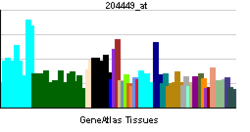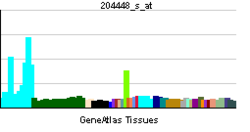- Phosducin-like
-
Phosducin-like Identifiers Symbols PDCL; DKFZp564M1863; PhLP External IDs OMIM: 604421 MGI: 1914716 HomoloGene: 38043 GeneCards: PDCL Gene Gene Ontology Molecular function • regulator of G-protein signaling activity Cellular component • cellular_component
• cytoplasmBiological process • signal transduction
• visual perception
• response to stimulusSources: Amigo / QuickGO RNA expression pattern 

More reference expression data Orthologs Species Human Mouse Entrez 5082 67466 Ensembl ENSG00000136940 ENSMUSG00000009030 UniProt Q13371 Q3UZN6 RefSeq (mRNA) NM_005388 NM_026176.3 RefSeq (protein) NP_005379 NP_080452.2 Location (UCSC) Chr 9:
125.56 – 125.59 MbChr 2:
37.21 – 37.21 MbPubMed search [1] [2] Phosducin-like protein is a protein that in humans is encoded by the PDCL gene.[1][2]
Phosducin-like protein is a putative modulator of heterotrimeric G proteins. The protein shares extensive amino acid sequence homology with phosducin, a phosphoprotein expressed in retina and pineal gland. Both phosducin-like protein and phosphoducin have been shown to regulate G-protein signaling by binding to the beta-gamma subunits of G proteins.[2]
References
- ^ Thibault C, Feng Wang J, Charnas R, Mirel D, Barhite S, Miles MF (May 1999). "Cloning and characterization of the rat and human phosducin-like protein genes: structure, expression and chromosomal localization". Biochim Biophys Acta 1444 (3): 346–54. PMID 10095058.
- ^ a b "Entrez Gene: PDCL phosducin-like". http://www.ncbi.nlm.nih.gov/sites/entrez?Db=gene&Cmd=ShowDetailView&TermToSearch=5082.
Further reading
- Miles MF, Barhite S, Sganga M, Elliott M (1993). "Phosducin-like protein: an ethanol-responsive potential modulator of guanine nucleotide-binding protein function.". Proc. Natl. Acad. Sci. U.S.A. 90 (22): 10831–5. doi:10.1073/pnas.90.22.10831. PMID 8248177.
- Lazarov ME, Martin MM, Willardson BM, Elton TS (1999). "Human phosducin-like protein (hPhLP) messenger RNA stability is regulated by cis-acting instability elements present in the 3'-untranslated region.". Biochim. Biophys. Acta 1446 (3): 253–64. PMID 10524200.
- Ruiz-Gómez A, Humrich J, Murga C, et al. (2000). "Phosphorylation of phosducin and phosducin-like protein by G protein-coupled receptor kinase 2.". J. Biol. Chem. 275 (38): 29724–30. doi:10.1074/jbc.M001864200. PMID 10884381.
- Lazarov ME, Martin MM, Willardson BM, Elton TS (2000). "Molecular cloning and characterization of the human phosducin-like protein (hPhLP) promoter.". Biochim. Biophys. Acta 1492 (2-3): 460–4. PMID 10899582.
- Hartley JL, Temple GF, Brasch MA (2001). "DNA cloning using in vitro site-specific recombination.". Genome Res. 10 (11): 1788–95. doi:10.1101/gr.143000. PMC 310948. PMID 11076863. http://www.pubmedcentral.nih.gov/articlerender.fcgi?tool=pmcentrez&artid=310948.
- Wiemann S, Weil B, Wellenreuther R, et al. (2001). "Toward a catalog of human genes and proteins: sequencing and analysis of 500 novel complete protein coding human cDNAs.". Genome Res. 11 (3): 422–35. doi:10.1101/gr.GR1547R. PMC 311072. PMID 11230166. http://www.pubmedcentral.nih.gov/articlerender.fcgi?tool=pmcentrez&artid=311072.
- Simpson JC, Wellenreuther R, Poustka A, et al. (2001). "Systematic subcellular localization of novel proteins identified by large-scale cDNA sequencing.". EMBO Rep. 1 (3): 287–92. doi:10.1093/embo-reports/kvd058. PMC 1083732. PMID 11256614. http://www.pubmedcentral.nih.gov/articlerender.fcgi?tool=pmcentrez&artid=1083732.
- McLaughlin JN, Thulin CD, Hart SJ, et al. (2002). "Regulatory interaction of phosducin-like protein with the cytosolic chaperonin complex.". Proc. Natl. Acad. Sci. U.S.A. 99 (12): 7962–7. doi:10.1073/pnas.112075699. PMID 12060742.
- Humrich J, Bermel C, Grubel T, et al. (2003). "Regulation of phosducin-like protein by casein kinase 2 and N-terminal splicing.". J. Biol. Chem. 278 (7): 4474–81. doi:10.1074/jbc.M206347200. PMID 12466282.
- Strausberg RL, Feingold EA, Grouse LH, et al. (2003). "Generation and initial analysis of more than 15,000 full-length human and mouse cDNA sequences.". Proc. Natl. Acad. Sci. U.S.A. 99 (26): 16899–903. doi:10.1073/pnas.242603899. PMC 139241. PMID 12477932. http://www.pubmedcentral.nih.gov/articlerender.fcgi?tool=pmcentrez&artid=139241.
- Gerhard DS, Wagner L, Feingold EA, et al. (2004). "The status, quality, and expansion of the NIH full-length cDNA project: the Mammalian Gene Collection (MGC).". Genome Res. 14 (10B): 2121–7. doi:10.1101/gr.2596504. PMC 528928. PMID 15489334. http://www.pubmedcentral.nih.gov/articlerender.fcgi?tool=pmcentrez&artid=528928.
- Wiemann S, Arlt D, Huber W, et al. (2004). "From ORFeome to biology: a functional genomics pipeline.". Genome Res. 14 (10B): 2136–44. doi:10.1101/gr.2576704. PMC 528930. PMID 15489336. http://www.pubmedcentral.nih.gov/articlerender.fcgi?tool=pmcentrez&artid=528930.
- Carter MD, Southwick K, Lukov G, et al. (2005). "Identification of phosphorylation sites on phosducin-like protein by QTOF mass spectrometry.". J Biomol Tech 15 (4): 257–64. PMID 15585822.
- Humrich J, Bermel C, Bünemann M, et al. (2005). "Phosducin-like protein regulates G-protein betagamma folding by interaction with tailless complex polypeptide-1alpha: dephosphorylation or splicing of PhLP turns the switch toward regulation of Gbetagamma folding.". J. Biol. Chem. 280 (20): 20042–50. doi:10.1074/jbc.M409233200. PMID 15745879.
- Lukov GL, Hu T, McLaughlin JN, et al. (2005). "Phosducin-like protein acts as a molecular chaperone for G protein betagamma dimer assembly.". EMBO J. 24 (11): 1965–75. doi:10.1038/sj.emboj.7600673. PMC 1142607. PMID 15889144. http://www.pubmedcentral.nih.gov/articlerender.fcgi?tool=pmcentrez&artid=1142607.
- Rual JF, Venkatesan K, Hao T, et al. (2005). "Towards a proteome-scale map of the human protein-protein interaction network.". Nature 437 (7062): 1173–8. doi:10.1038/nature04209. PMID 16189514.
- Mehrle A, Rosenfelder H, Schupp I, et al. (2006). "The LIFEdb database in 2006.". Nucleic Acids Res. 34 (Database issue): D415–8. doi:10.1093/nar/gkj139. PMC 1347501. PMID 16381901. http://www.pubmedcentral.nih.gov/articlerender.fcgi?tool=pmcentrez&artid=1347501.
- Lukov GL, Baker CM, Ludtke PJ, et al. (2006). "Mechanism of assembly of G protein betagamma subunits by protein kinase CK2-phosphorylated phosducin-like protein and the cytosolic chaperonin complex.". J. Biol. Chem. 281 (31): 22261–74. doi:10.1074/jbc.M601590200. PMID 16717095.
- Olsen JV, Blagoev B, Gnad F, et al. (2006). "Global, in vivo, and site-specific phosphorylation dynamics in signaling networks.". Cell 127 (3): 635–48. doi:10.1016/j.cell.2006.09.026. PMID 17081983.
Categories:- Human proteins
- Chromosome 9 gene stubs
Wikimedia Foundation. 2010.
